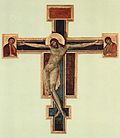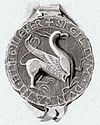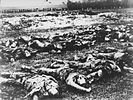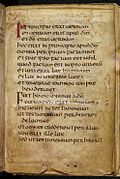Wikipedia:Today's featured article/April 2017
| << | Today's featured articles for April 2017 | >> | ||||
|---|---|---|---|---|---|---|
| Su | Mo | Tu | We | Th | Fr | Sa |
| 1 | ||||||
| 2 | 3 | 4 | 5 | 6 | 7 | 8 |
| 9 | 10 | 11 | 12 | 13 | 14 | 15 |
| 16 | 17 | 18 | 19 | 20 | 21 | 22 |
| 23 | 24 | 25 | 26 | 27 | 28 | 29 |
| 30 | ||||||
April 1

Nominative determinism is the hypothesis that people are drawn to professions that fit their name. The term was first used in the magazine New Scientist in 1994, after its humorous Feedback column mentioned a book on polar explorations by Daniel Snowman and an article on urology by researchers named Splatt and Weedon. The hypothesis had been suggested by psychologist Carl Jung, citing as an example Sigmund Freud (German for "joy"), who studied pleasure. A few recent empirical studies have indicated that certain professions are disproportionately represented by people with appropriate surnames, though the methods of these studies have been challenged. One explanation for nominative determinism is the theory of implicit egotism, which states that humans have an unconscious preference for things they associate with themselves. An alternative explanation is genetic: an ancestor might have been named Smith or Taylor according to their occupation, and the genes they passed down might correlate to aptitudes for those professions. (Full article...)
April 2
Courtney Love (born 1964) is an American singer and actress. Combining uninhibited live performances with confrontational lyrics, she was prolific in the punk and grunge scenes of the 1990s as the frontwoman of the alternative rock band Hole, which she formed in 1989. She was married to Kurt Cobain, frontman for Nirvana, until his suicide in 1994. Hole's second release, Live Through This (1994), achieved critical accolades and multi-platinum sales. In 1995, Love earned a Golden Globe Award nomination for her performance in The People vs. Larry Flynt (1996). Hole's third album, Celebrity Skin (1998), was nominated for multiple Grammy Awards. After roles in the big-budget pictures Man on the Moon (1999) and Trapped (2002), she released her first solo album, America's Sweetheart (2004). She was sentenced to a rehabilitation facility in 2005 on drug charges. She returned to the music industry with Nobody's Daughter (2010), another Hole album, but without any other members of the original lineup. In 2014 and 2015, she released two solo singles and returned to acting in the network series Empire and Sons of Anarchy. (Full article...)
April 3
The camas pocket gopher (Thomomys bulbivorus) is a rodent native to the Willamette Valley of northwestern Oregon in the United States. The herbivorous mammal collects its food in large, fur-lined, external cheek pouches, then hoards any surplus in underground tunnels. The coat, dull brown to lead gray, changes color and texture over the year. The gophers' large, protuberant incisors are well adapted for use in tunnel construction, particularly in the hard clay soils of the Willamette Valley. They make chattering sounds with their teeth; males and females make purring (or crooning) sounds when they are together, and the young make twittering sounds. Born toothless, blind and hairless, the young grow rapidly before being weaned at about six weeks of age. The species is prey for raptors and carnivorous mammals, and host to several parasitic arthropods and worms. While population trends are generally stable, threats to the species' survival include urbanization, habitat conversion for agricultural use and active attempts at eradication with trapping and poisons. Fiercely defensive when cornered, the gopher may become tame in captivity. (Full article...)
April 4
The Heart of a Woman (1981) is the fourth of seven autobiographies by American writer Maya Angelou (pictured). She recounts events in her life between 1957 and 1962, as she travels to California, New York, Cairo and Ghana, and raises her teenage son. She becomes a published author active in the US civil rights movement, and is romantically involved with a South African freedom fighter. The book explores Angelou's theme of motherhood, and ends as she looks forward to newfound independence and freedom when her son leaves for college. Although most critics consider Angelou's first autobiography I Know Why the Caged Bird Sings more favorably, The Heart of a Woman has received positive reviews and was chosen as an Oprah's Book Club selection in 1997. The title is taken from a poem by Harlem Renaissance poet Georgia Douglas Johnson. "Faithful to the ongoing themes of survival, sense of self, and continuing education," according to critic Lyman B. Hagen, "The Heart of a Woman moves its central figures to a point of full personhood". (Full article...)
Part of the Maya Angelou autobiographies featured topic.
April 5
The Shackleton–Rowett Expedition (1921–22) was Sir Ernest Shackleton's last Antarctic project, and the final episode in the Heroic Age of Antarctic Exploration. The venture, with vaguely defined geographic and scientific objectives, was financed by John Quiller Rowett, and is otherwise known as the Quest Expedition after its ship Quest, a converted Norwegian sealer. Shackleton had originally intended to go to the Arctic and explore the Beaufort Sea, but abandoned this plan when the Canadian government withheld financial support. Shortly after Quest's arrival at South Georgia, Shackleton died of a heart attack, aged 47. The expedition continued under the leadership of Frank Wild, with a three-month cruise to the eastern Antarctic, but the shortcomings of Quest as a polar vessel kept it from proceeding further than longitude 20°E, or from penetrating southward through the pack ice. After returning to South Georgia, Wild hoped for a second, more productive season in the ice, and took the ship to Cape Town for a refit, where he found a message from Rowett ordering them home. The expedition ended quietly, with limited achievements. (Full article...)
April 6
The 7th Army was a Royal Yugoslav Army formation, raised three days before the German-led invasion of Yugoslavia of 6 April 1941, during World War II. On the first day of the invasion, the army's commander Dušan Trifunović was alarmed when the 4th Army, on the right flank of the 7th, was undercut by fifth column activities by Croats within its major units and higher headquarters. The Germans captured Maribor two days later and expanded their bridgeheads, supported by the Luftwaffe. On 10 April, the German 14th Panzer Division captured Zagreb. Italian offensive operations began the following day, with thrusts towards Ljubljana and down the Adriatic coast, capturing more than 30,000 Yugoslav troops near Delnice. When fifth column supporters of the Croatian nationalist Ustaše movement arrested the headquarters staff of the 7th Army later that day, the formation effectively ceased to exist. On 12 April, the Germans linked up with the Italians near the Adriatic coast, encircling the remnants of the 7th Army, which offered no further resistance. Ceasefires were implemented on 15 April, and the Yugoslav Supreme Command surrendered unconditionally. (Full article...)
April 7
Gabriel Pleydell was an English landowner and politician. Born before 1519 into a large, affluent family, he became a Member of Parliament for Wootton Bassett in 1553, close to his family estate at Midgehall in Wiltshire. His election to the Marlborough constituency two years later may have been made possible by his father's influential connections. He returned to the Wootton Bassett seat in 1563 at the request of Sir John Thynne, whom he had supported in a dispute over the Knighthood of the Shire in 1559. He was alleged to be one of the ringleaders of a plot to exile Queen Mary I of England, and made a contentious claim of parliamentary privilege after he was found guilty of this offence in 1555, an action which caused serious disagreement between the House of Commons and the House of Lords. Legal accusations for most of his political career and imprisonment in Fleet Prison and the Tower of London helped "confirm for Gabriel Pleydell a niche in parliamentary history", according to a modern historian. He died in 1590 or 1591. (Full article...)
April 8
"Yesterday's Enterprise" is the 63rd episode of the television series Star Trek: The Next Generation. It was the 15th episode of the third season, first airing in syndication the week of February 19, 1990. In the story, the crew of the USS Enterprise (NCC-1701-D) must decide whether to send the time-traveling Enterprise-C back through a temporal rift to its certain destruction, to prevent damaging changes to their own timeline. The plot merged two storylines that had been developed separately, one featuring the crew of the time-traveling ship and another featuring the return of Denise Crosby (pictured), whose character had been killed in the show's first season. Trent Christopher Ganino and Eric A. Stillwell rewrote the merged story to focus on Whoopi Goldberg's character, Guinan. Filming lasted a week. In syndication, "Yesterday's Enterprise" outperformed most of the third season's episodes with a 13.1 Nielsen rating, the third-highest for the series at the time. The episode is cited as a favorite by reviewers, and is widely regarded as one of the best episodes of the series. (Full article...)
April 9
The Canadian National Vimy Memorial in France is dedicated to the memory of Canadian Expeditionary Force members and other Canadians killed during the First World War. Designed by Walter Seymour Allward, the monument is the centrepiece of a 100-hectare (250-acre) battlefield park, overlapping the site of the Battle of Vimy Ridge offensive (9 April 1917) that began the Battle of Arras. In that offensive, all four divisions of the Canadian Expeditionary Force participated as a cohesive battle formation for the first time, and it became a Canadian national symbol of achievement and sacrifice. France ceded the land to Canada for its memorial. Wartime tunnels, trenches, craters, and unexploded munitions still honeycomb the grounds, which are largely closed off for public safety. Preserved trench lines and several other memorials and cemeteries are contained within the park. King Edward VIII unveiled it in July 1936, and Queen Elizabeth II re-dedicated the restored monument on the 90th anniversary of the offensive. The site, one of only two National Historic Sites of Canada outside the country, is maintained by Veterans Affairs Canada. (Full article...)
April 10
Noel Park in north London is a planned community designed by Rowland Plumbe in the late 19th century, consisting of 2,200 model dwellings. It was developed in open countryside to the north of London between the historic villages of Highgate and Tottenham by the Artizans, Labourers & General Dwellings Company. One of the earliest garden suburbs in the world, it provided affordable housing for working-class families wishing to leave the inner city. Every property had a front and rear garden, and it was close enough to the rail network to allow its residents to commute to work. In line with the principles of the company's founder, William Austin, it had no pubs, and there are still none today. As a result of London's rapid expansion during the early 20th century, and particularly after the London Underground was extended to the area in 1932, Noel Park was surrounded by later developments. In 1965, it was incorporated into the newly created London Borough of Haringey. Despite damage during World War II and demolition work during the construction of Wood Green Shopping City in the 1970s, it remains largely architecturally intact. (Full article...)
April 11
Margaret Lea Houston (April 11, 1819 – December 3, 1867) was First Lady of the Republic of Texas, First Lady of the state of Texas, and a founding member of Concord Baptist Church in Grand Cane. She was a poet and an accomplished musician. Her influence on husband Sam Houston persuaded him to give up alcohol and profane language. Margaret gave birth inside the governor's mansion to the youngest of their eight children, as angry mobs gathered outside in response to her husband's opposition to Texas signing the Ordinance of Secession of the Civil War. He was removed from office for refusing to swear loyalty to the Confederacy. Their eldest son joined the Confederate army and was left for dead on the battlefield at Shiloh, saved by a Union Army clergyman who found a Bible from Margaret in his pocket. Sam Houston died of illness before the end of the war, as Margaret sat by his bed reading to him from the 23rd Psalm. She became the keeper of his legacy and opened his records to a trusted biographer. When she died of yellow fever, Margaret could not be buried with her husband in a public cemetery for fear of contamination, and was instead interred on private family property. (Full article...)
April 12
Everglades National Park is a U.S. National Park in Florida that protects the southern 20 percent of the original Everglades. It is the largest tropical wilderness in the United States and the third-largest national park in the lower 48 states after Death Valley and Yellowstone. The park was established in 1934 when canal-building projects in South Florida were threatening the quickly vanishing Everglades, a network of wetlands and forests fed by a river flowing out of Lake Okeechobee into Florida Bay. It was the first national park created to protect a fragile ecosystem. The park is the most significant breeding ground for tropical wading birds in North America and contains the largest mangrove ecosystem in the western hemisphere. It is home to 36 threatened or protected species including the Florida panther, the American crocodile, and the West Indian manatee, and supports 350 species of birds, 300 species of fresh and saltwater fish, 40 species of mammals, and 50 species of reptiles. Most of South Florida's fresh water comes from the Biscayne Aquifer, which is replenished by the Everglades. (Full article...)
Part of the Everglades featured topic.
April 13
Fez is an indie puzzle-platform video game developed by Polytron and published by Trapdoor, first released on April 13, 2012, for Xbox Live Arcade. The player-character Gomez receives a fez that reveals his two-dimensional (2D) world to be one of four sides of a three-dimensional (3D) world. The player rotates between these four 2D views to realign platforms and solve the game's puzzles. Designer Phil Fish appeared in the 2012 documentary Indie Game: The Movie, which detailed Fez's final stages of development and Polytron's related legal issues. Reviewers commended the game's emphasis on discovery and freedom, but criticized its technical issues, in-game navigation, and endgame backtracking. They likened the game's rotation mechanics to the 2D–3D shifts of Echochrome, Super Paper Mario, and Crush. Fez won the Seumas McNally Grand Prize and Eurogamer's 2012 Game of the Year award. It sold one million copies by the end of 2013, and influenced games such as Monument Valley, Crossy Road, and Secrets of Rætikon. (Full article...)
April 14
The Crucifix by Cimabue at Santa Croce is a large wooden crucifix painted c. 1265, one of two attributed to the Florentine painter and mosaicist Cimabue. Painted in distemper, it was commissioned by the Franciscan friars of Santa Croce and is built from a complex arrangement of timber boards. Displaying technical innovations and humanistic iconography, it is one of the first Italian artworks to break from the late medieval Byzantine style. The gilding and monumentality of the cross link it to the Byzantine tradition. Christ's static pose is reflective of this style, while the work overall incorporates newer, more naturalistic aspects. It presents a lifelike and physically imposing depiction of the passion at Calvary. Christ is shown nearly naked: his eyes are closed, his face lifeless and defeated. His body slumps in a position contorted by prolonged agony and pain. The painting is a graphic and unflinching portrayal of human suffering, and has influenced painters from Michelangelo to Francis Bacon. It has been in the Basilica di Santa Croce since the late 13th century, and at the museum at Santa Croce since restoration following flooding of the Arno in 1966. (Full article...)
April 15
Me and Juliet is a musical comedy with music by Richard Rodgers and lyrics and book by Oscar Hammerstein II. The story deals with romance between the cast and crew backstage at a long-running musical, a show-within-the-show (also named Me and Juliet). The musical premiered in 1953 and ran for almost a year on Broadway, closing after it exhausted its advance sales. It received no Tony Award nominations. The play required complex machinery, designed by Jo Mielziner, so that the audience could view action not only on the stage but also in the wings and high above the stage near the spotlights. The show garnered less than favorable reviews, though Mielziner's staging won praise from audiences and critics. With the exception of a short run in Chicago, there was no national tour, and the show is rarely seen—although a small-scale production was presented by London's Finborough Theatre in 2010. "No Other Love" from the show became a hit record in 1953 for Perry Como and in 1956 for Ronnie Hilton. (Full article...)
April 16
King Kalākaua's world tour in 1881 made him the first monarch to circumnavigate the globe. His agenda was to negotiate contract labor for the Kingdom of Hawaii's sugar plantations, with hopes of saving the dwindling Native Hawaiian population by drawing immigration from Asia-Pacific nations. Rumors circulated that the King secretly intended to use the trip to sell the Hawaiian Islands to the highest bidder. He visited American legislators and had an audience with the Pope in Rome. He also met with European and Asian heads of state, and was influenced by their ornate ceremonies and displays of military power. In between negotiations, Kalākaua and his companions visited tourist sites and attended local Freemasonry lodge meetings. As a result of his visit with Thomas Edison on the return trip through New York, Iolani Palace later became the first building in Hawaii with electric lighting. Kalākaua's amiable personality generated goodwill around the world, and he succeeded in increasing Hawaii's labor force. The Japanese workers he attracted were commemorated a century later with a new statue of Kalākaua in Waikiki. (Full article...)
April 17
Villa Park is an association football stadium in Aston, Birmingham, England, with a seating capacity of 42,682. Formerly a sports ground in a Victorian amusement park, it has been the home of Aston Villa Football Club since 17 April 1897. The ground has hosted sixteen England internationals at senior level, the first in 1899 and the most recent in 2005. It has hosted 55 FA Cup semi-finals, more than any other stadium. The club has initial planning permission to redevelop its North Stand, which will increase its capacity to around 50,000. Aside from football-related uses, the stadium has seen concerts and other sporting events, including boxing matches and international rugby league and rugby union matches. In 1999, the last ever final of the UEFA Cup Winners' Cup took place at Villa Park. It also hosted the 2012 FA Community Shield, as Wembley Stadium was being used for the final of the Olympic football tournament. (Full article...)
Part of the Aston Villa F.C. featured topic.
April 18

The Roman and Han Chinese empires saw an exchange of trade goods, information, and occasional travelers, as did the later Eastern Roman Empire and various Chinese dynasties. These empires inched progressively closer in the course of the Roman expansion into the ancient Near East and simultaneous Han Chinese military incursions into Central Asia. Mutual awareness remained low and firm knowledge about each other was limited. Only a few attempts at direct contact are known from records. Several alleged Roman emissaries to China were recorded by ancient Chinese historians. The indirect exchange of goods along the Silk Road and sea routes included Chinese silk, Roman glassware (example pictured) and high-quality cloth. Roman coins minted since the 1st century AD have been found in China. A coin of Maximian and medallions from the reigns of Antoninus Pius and Marcus Aurelius were found in Vietnam. Roman glasswares and silverwares have been discovered at Chinese archaeological sites dated to the Han period. Roman coins and glass beads have also been found in Japan. (Full article...)
April 19
Donnchadh (Duncan), Earl of Carrick (died 1250), was a Gall-Gaidhil prince and one of the longest serving magnates in medieval Scotland. His father, Gille-Brighde of Galloway, and his uncle, Uhtred of Galloway, were the two rival sons of Fergus, Lord of Galloway. As a result of Gille-Brighde's conflict with Uhtred and the Scottish monarch William the Lion, Donnchadh became a hostage of King Henry II of England. He probably remained in England for almost a decade before returning north on the death of his father. Although denied succession over all the lands of Galloway, he was granted lordship over Carrick in the north. Allied to John de Courcy, Donnchadh fought battles in Ireland, acquiring and losing land there. A patron of religious houses, particularly Melrose Abbey and North Berwick priory nunnery, he attempted to establish a monastery in his own territory, at Crossraguel. He married the daughter of Alan fitz Walter, a leading member of the family later known as the House of Stewart—future monarchs of Scotland and England. His descendants include the Bruce, the Stewart Kings of Scotland, and probably the Campbell Dukes of Argyll. (Full article...)
April 20
Kona Lanes was a 40-lane bowling center in Costa Mesa, California, that closed in 2003 after 45 years in business. Built during the advent of Googie architecture, its Polynesian Tiki-themed styling extended from the large roadside neon sign to what the Los Angeles Times called the building's "flamboyant neon lights and ostentatious rooflines meant to attract motorists like moths". At its peak, Kona Lanes was open 24 hours a day, averaging more than 80 ten-frame games of bowling on each of its 40 lanes. The center also hosted music concerts and other events. Following years of decline, Kona Lanes closed and was torn down in 2003; a portion of the distinctive sign (pictured) was saved and sent to Cincinnati, Ohio, for display in the American Sign Museum. Plans for a department store on the Kona Lanes site were rejected; in 2010, the still-unused land was rezoned for senior citizens' apartments and commercial development. Construction on the apartment complex began in 2013 after the lot had sat empty for ten years. (Full article...)
April 21
SMS Kaiser Barbarossa (His Majesty's Ship Emperor Barbarossa) was a German pre-dreadnought battleship of the Kaiser Friedrich III class. Built at Schichau in Danzig under Kaiser Wilhelm II's program of naval expansion, the battleship was laid down in 1898, launched on 21 April 1900, and commissioned the next year at a cost of 20,301,000 Marks. Armed with a main battery of four 24-centimeter (9.4 in) guns in two twin gun turrets, the ship's active career in the Imperial Navy was limited by two lengthy stays in dry dock, and she was decommissioned in 1909. Following the outbreak of World War I in August 1914, she and her sister ships were mobilized as coastal defense ships and assigned to the North and Baltic seas, but saw no combat during the war. They were withdrawn from active duty the next year and relegated to secondary duties. Kaiser Barbarossa was decommissioned after the war and broken up in 1919 and 1920. (Full article...)
Part of the Battleships of Germany featured topic.
April 22
Carnotaurus, a large theropod dinosaur, lived during the Late Cretaceous period. Known from a single well-preserved skeleton found in Argentina, it is a member of the Abelisauridae family, and one of the best-understood theropods from the Southern Hemisphere. Carnotaurus (derived from Latin for "meat-eating bull") had thick horns above the eyes, and a very deep skull on a muscular neck. It was a lightly built, bipedal predator, 8 to 9 m (26.2 to 29.5 ft) long, weighing at least 1.35 metric tons (1.49 short tons). It had small, vestigial forelimbs and long and slender hindlimbs. Preserved skin impressions show a mosaic of small scales interrupted by large bumps that lined the sides of the animal. The horns and neck may have been used in fighting others of its kind. Its feeding habits remain unclear: some studies suggest the animal was able to hunt down very large prey, while other studies find it preyed mainly on small animals. Carnotaurus may have been one of the fastest large theropods. (Full article...)
April 23
The Shakespeare authorship question is the argument, first raised in the 19th century, that someone other than William Shakespeare of Stratford-upon-Avon wrote the works attributed to him. All but a few Shakespeare scholars and literary historians consider it a fringe belief. Anti-Stratfordians believe that Shakespeare was a front to shield the identity of the real author or authors, who for some reason did not want or could not accept public credit. The controversy has spawned a vast body of literature, and more than 80 authorship candidates have been proposed, the most popular being Francis Bacon, Edward de Vere, Christopher Marlowe, and William Stanley. To the claim that Shakespeare lacked sufficient education, aristocratic sensibility, or familiarity with the royal court for a writer of such eminence and genius, scholars reply that there is much documentary evidence supporting his authorship—title pages, testimony by contemporary poets and historians, official records—and none supporting any other candidate. (Full article...)
April 24
"The Shape of Things to Come" is the 81st episode of the American Broadcasting Company television series Lost, and the ninth episode of the fourth season. First airing on April 24, 2008, in the U.S. and Canada, it was written by Drew Goddard and Brian K. Vaughan and directed by Jack Bender. The narrative centers on Ben Linus, played by Michael Emerson (pictured), as he and the Oceanic Airlines Flight 815 crash survivors at the Barracks come under attack in December 2004, while flashforwards to late 2005 show him recruiting Sayid Jarrah (Naveen Andrews) as a hitman and confronting his enemy Charles Widmore (Alan Dale). Production was paused by the 100-day Writers Guild of America strike. "The Shape of Things to Come" received positive critical reviews and the original broadcast was watched by 14 million Americans. Much praise was directed at Emerson's acting skills, particularly in his reaction to the execution of his character's daughter Alex (Tania Raymonde). His performance in this episode garnered a nomination for Outstanding Supporting Actor in a Drama Series for the 60th Primetime Emmy Awards, and the episode was nominated in the category of Outstanding Sound Editing for a Series. (Full article...)
April 25
George Calvert, 1st Baron Baltimore (1579–1632), was a Member of Parliament and later Secretary of State under King James I. He lost much of his political power after his support for a failed marriage alliance between Prince Charles and the Spanish House of Habsburg royal family, and resigned all his offices in 1625 except for his position on the Privy Council. After declaring his Catholicism publicly, he was created Baron Baltimore in the Irish peerage. He took an interest in the British colonisation of the Americas, at first for commercial reasons and later to create a refuge for English Catholics. He became the proprietor of Avalon, the first sustained English settlement on the southeastern peninsula of the island of Newfoundland. Discouraged by its cold climate and the sufferings of the settlers, he looked for a more suitable spot and sought a new royal charter to settle what would become the state of Maryland. Calvert died five weeks before the new Charter was sealed, leaving the settlement of the Maryland colony to his son Cecil. His second son Leonard was the first colonial governor of the Province of Maryland. (Full article...)
April 26
Heffernan v. City of Paterson was a U.S. Supreme Court case concerning the First Amendment rights of public employees, decided on April 26, 2016. Jeffrey Heffernan, a detective with the Paterson, New Jersey, police force, was seen with a lawn sign for the candidate challenging the city's incumbent mayor. Heffernan's supervisors mistakenly thought that he was actively supporting the challenger and demoted him. He brought suit alleging that his demotion violated his right to free speech. Writing for a majority of the Supreme Court, Justice Stephen Breyer (pictured) cited the Court's precedents, which had held that it is unconstitutional for a government agency to discipline an employee for engaging in partisan political activity, as long as that activity is not disruptive to the agency's operations. Even if Heffernan was not actually engaging in protected speech, he wrote, the discipline against him sent a message to others to avoid exercising their rights. Justice Clarence Thomas wrote a dissenting opinion, joined by Justice Samuel Alito, in which he agreed that Heffernan had been harmed but not that his constitutional rights had been violated. (Full article...)
April 27
The Greencards are a progressive bluegrass band founded in 2003 in Austin, Texas, by Englishman Eamon McLoughlin and Australians Kym Warner and Carol Young. They relocated in 2005 to Nashville, Tennessee. Their albums include Movin' On (2003), Weather and Water, Viridian (2007), and Fascination (2009). Their sound has been compared to progressive American folk rock. Country Music Television named Weather and Water one of the ten best bluegrass albums of 2005, and The Greencards were invited to tour with Bob Dylan and Willie Nelson the same year. Viridian, a critically praised album, was number one on Billboard magazine's Bluegrass Music Chart, and was nominated for Best Country Album by the Australian Recording Industry Association. The "Mucky the Duck" track was nominated for Best Country Instrumental Performance at the 50th Grammy Awards. McLoughlin left the band in December 2009, and Carl Miner joined in May 2010. Credited with helping to expand the range of bluegrass music, they draw from Irish folk music, Romani music, rock 'n' roll, folk balladry, and Latin American musical sources. (Full article...)
April 28
The Gudovac massacre was the killing of around 190 Serb civilians by the Croatian nationalist Ustaše movement on 28 April 1941, during World War II. It occurred shortly after the Axis invasion of Yugoslavia and the establishment of the Ustaše-led puppet state known as the Independent State of Croatia. It was the first Ustaše massacre of Serb civilians and presaged a wider genocide against them that would last until the end of the war. The Ustaše used the deaths of two of their local followers as a pretext for the killings. The victims were drawn from the Gudovac district, taken to a nearby field and shot en masse. Five survived the initial shooting and crawled away. The victims were then buried in a mass grave. The Germans soon became aware of the killing and dug up some of the bodies; they arrested 40 suspects, who were released following the intervention of a senior Ustaše official. Monuments were erected on the site of the massacre in 1955, but destroyed by Croatian nationalists in 1991, amid inter-ethnic warfare. A restored monument was unveiled at the site in December 2010. (Full article...)
April 29
Little Nemo (1911) is a silent animated short film, the first by American cartoonist Winsor McCay. One of the earliest animated films, it features characters from his comic strip Little Nemo in Slumberland. The film's expressive character animation distinguished it from the earlier experiments of animators such as James Stuart Blackton and Émile Cohl. McCay, inspired by flip books his son brought home, came to see the potential of the animated film medium. The short's four thousand drawings on rice paper were shot at Vitagraph Studios under Blackton's supervision. Most of the film is a live-action sequence in which McCay bets his colleagues that he can make drawings that move. He wins the bet with four minutes of animation in which the characters perform, interact, and metamorphose to McCay's whim. After the film debuted, he began using it in his vaudeville act. The film's enthusiastic reception motivated him to hand-color each of the animated frames of the originally black-and-white film. Its success led him to create more animated films, including How a Mosquito Operates in 1912, and his best-known film, Gertie the Dinosaur, in 1914. (Full article...)
April 30
The St Cuthbert Gospel is an early 8th-century pocket Gospel book, written in Latin. The essentially undecorated text is the Gospel of John in Latin, written in a script that has been regarded as a model of elegant simplicity. Its finely decorated leather binding is the earliest known Western bookbinding to survive, and both the 94 vellum folios and the binding are in outstanding condition for a book of its age. It is one of the smallest surviving Anglo-Saxon manuscripts. The book takes its name from Saint Cuthbert of Lindisfarne, North East England, in whose tomb it was placed. It was probably a gift from Monkwearmouth-Jarrow Abbey, where it was written, intended for St Cuthbert's coffin within a few decades after this was placed behind the altar at Lindisfarne in 698. It presumably remained in the coffin through its long travels after 875, forced by Viking invasions, ending at Durham Cathedral. The book was found inside the coffin and removed in 1104. After the Dissolution of the Monasteries in England by Henry VIII between 1536 and 1541, the book passed to collectors, and is now owned by the British Library. (Full article...)


























